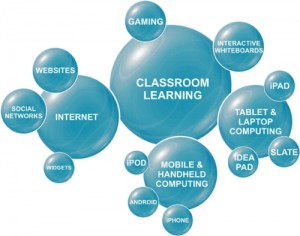 Uninspired in a digital age?
Uninspired in a digital age?
Does anyone else find the most recent release of support resources for CfE from Education Scotland uninspiring? I’m really happy to have a level of support but my problem is that I’d hoped for much more than the standard paper support pack and set of notes.
If Glow is the primary means of providing national support for CfE then we need more than just to use a Glow login to access non-digital resources. To me there is a huge disconnect from the stated intention of supporting CfE with Glow and what is being provided to practitioners across the country. This disconnect is partly due to the structure of our national support agency, Education Scotland, and to the approach adopted by many, across all sectors of Scottish Education, to the use of technologies.
Now, don’t get me wrong – I am not “having a go” at the support for CfE. Resources have been produced to provide exemplification and guidance but I think we are missing a trick by not using technology to create more “blended learning” experiences. So first to the issues!
 Bring it together
Bring it together
First, the structural issue in Education Scotland. The main support for CfE sits with the schools directorate. Subject focused development officers are deployed within this directorate, however, the development of Glow sits in the directorate for strategy, performance and corporate resources. From memory these are Directorates B and D and from what I can gather there is little interaction between those developing and supporting CfE and those developing and supporting Glow and Emerging Technologies.
Now, if I had to develop a strategy to drive adoption of Glow, and meaningful support for CfE, I would bring these two sides of our national education support agency together to create a number of national online hubs within Glow. I’d start with the senior phase and create national hubs (by hub I mean a one stop online community where you get everything you need in one place!) to reflect the new national qualification subjects for which SQA are about to publish final updated arrangements. I’d put these as headline tiles or buttons on our national portal so that everyone knew they were there! And I’d have a CfE development officer and a Glow development officer “buddied” up to support one or more national hubs. They would curate these hubs and support the communtiy.
In these “hubs” I would host all the arrangements documents, Education Scotland produced support resources, assessment items from NAR and other relevant nationally procured content such as the Twig video resources. The national hubs would have an upload/download area so that resources from practitioners could be crowd-sourced from the teaching community (just as we currently do in CompEdNet.com). There would also be a quick “Like” function/button so practitioners could indicate, in a positive way, if a resource was helpful.
Also, in the national hub would be a discussion forum to allow practitioners to post questions and get answers from the community. Updates from these discussions would be pushed out to members via email. This way you don’t have to visit the hub to know what is going on. If a resource is uploaded you’ll know about it, if a question is asked you’ll get it in your inbox.
Into these hubs I would bring SQA appointees and HMIe to offer advice and direction within the online community to support the development of Curriculum for Excellence. Better to have the guidance from our national support bodies gathered in one place for all to see rather than have it scattered across multiple documents and multiple sites. Yes, making public online comment on learning and teaching and providing online guidance would require a change of culture from our appointees and inspectorate but surely a new and “open” dialogue between professionals should be encouraged?
Glow can’t be seen as a contentless space in our digital landscape. We need to help users find the content that is important for them and organising into national hubs of this nature will do just that. After implementing hubs for the senior phase, I would create hubs based on curricular areas for the junior phase of secondary and for primary (I’m not a primary specialist and if I was leading a project like this I would engage with primary colleagues to identify the best way to focus national hubs to meet their needs as practitioners).
 Content is King
Content is King
If we focus our development of Glow on generating content filled national hubs then we give teachers compelling reasons to return and to continue to return to Glow on a daily/weekly basis. Without content Glow becomes nothing more than a very expensive experiment with digital tools and a space where very little happens. An analysis of the Glow usage figures for the week of Jan 27th 2013 (the last that data is available for) shows that 21% of teachers had logged into Glow in the previous 4 weeks as had 7.1% of learners. Now, I have to express some caution about the figures for January. When you look at the annual cycle of Glow usage January is the month where usage peaks, often because of the use of Glow to access resources for snow days/school closures. If you take a broader view then typical usage of Glow is 60% to 70% less than these figures .
On average, based on aggregating the published data, in a typical four week period across Scotland, 3% of learners and about 8% of teachers use Glow. (There is some margin for error in these figures as Education Scotland do not publish a spreadsheet of data but rather publish separate charts for each local authority as PDF documents) – there are no publicly available overall statistics – which means I’ve had to analyse each LAs figures and generate estimated figures from the published charts).
These figures show that we REALLY need to give users a reason to access Glow.

Blended Learning
With the international trend moving towards much greater use of technology to provide online learning experiences, and initial research showing promising results on the outcome of these experiences, surely it is time to use technology as an integral part of our learning experience and not just a digital filing cabinet for resources.
Some reimaging of the support for our new national curriculum and qualifications is required. Where are the resources to support a flipped model of learning? How are we making use of resources such as the Khan Academy, TedEd, YouTube and others? Why are we not, at a national level, partnering with Khan Academy or TedEd to create free resources focused on CfE? The tools are already there for us!
How can we construct learning experiences within Glow, which are supported via our “national hubs”, that allow learners to progress at their own pace, complete online formative assessment and receive deep feedback and support from their teachers? Do we crowd-source content, use nationally procured and user-generated video, share assessments and deploy assessments from SQA Solar and NAR? Surely, we can do this. Much of the rest of the world already is.
And, as I’ve said before, with a promise from SQA for online assessment and certification, surely now is the time to build national learning experiences using the collective knowledge of the teaching profession, HMIe and SQA.
I understand the risks
Now, there are some risks with this approach to building national hubs and blended learning experiences to support Curriculum for Excellence. First of all, you are betting the house on the use of Glow (a system which hasn’t had to go far to find it’s critics in recent years). But the next version of Glow using Office 365 for Education is slicker, more streamlined and less clunky – not perfect but a significant improvement on the previous version.
Another risk inherent in a move to more digitally focused support is an assumption about the technical proficiency of our nations teachers. However, I don’t think it is acceptable for any teacher to say “I don’t do ICT” after all, we’ve updated the requirements of initial teacher education to give greater emphasis to ICT and we’ve invested millions in training for teachers (from New Opportunities Fund in there late 1990s’ to Masterclass and Glow mentoring). The truth is, that just like any other job, teachers now have to get to grips with technology and they have had more support than most groups to do so. So, I don’t think it’s a risk to focus our CfE support on Glow and I actually think that by building the support in Glow we give many teachers a reason to get over their ICT fears.
But we still need to make it simple for users to use Glow and we should never forget that the best online tools are intuative and easy to use.
And the argument that young people don’t have access to technology? There will always be a small group who don’t have access to technology but we can make arrangements in school to support them however, the Scottish Household Survey of 2011 shows that 96% of young people in the age range 16-24 use the Internet and the trend continues to rise upwards. Surely, this means that a significant number of our learners 15 and below have access? I would suggest that a move towards greater use of digital learning resources is a safe bet in a time of increasing use of technology.
 And we are doing this already…
And we are doing this already…
Yes, already in Glow, Education Scotland DOs are making examples of learning experiences that support this idea of blending learning, mixing the best of online with the direction and support of the class teacher. Take a peek at the “Look, Capture, Create” group developed in conjuction with Dundee Contemporary Arts. A great collection of discussion, GlowTV Video, Wiki and more including contributions from learners.
And it doesn’t have to be all digital!
The whole idea of blended learning is that it doesn’t have to be all digital. In fact, a meta-analysis (essentially an agregation of published research) carried out by the US department of Education showed that teacher lead and online only learning were about equal in the contribution they made to a learners achievement BUT that a sizeable gain was achieved when the two were mixed in blended learning experiences. The combination of online materials (ideally replacing the teacher’s “lecture”), deep, active learning and detailed feedback in class resulted in improvements in the outcomes for learners.
Focus on support
So take the support effort for CfE and get the development officers and staff from the two directorates of Education Scotland to work closely together. Don’t under-estimate the time and support required to build high quality digital resources and blended learning experiences but if we can get the hubs right and bring in our nations teachers then we can crowd-source and increase the effectiveness of our national support exponentially.


robertd1981
RT @charlie_love: Glow & CfE support – the elephant in the room? Where is technology across learning to support CfE? http://t.co/z3sblT9ZRp
gartmor
http://t.co/pqWuCBeF78 Some very interesting observations from @charlie_love- possibly some things for Wales to think about?
hambudge
Glow and CfE support – the elephant in the room? http://t.co/bvRCUr8q9u What elephant? 😉
MrMcEnaney
@hambudge @charlie_love I got frustrated at what was provided and made http://t.co/eKcr4oapEp (partly inspired by Glew)
teacherreid
RT @charlie_love: Glow and CfE support. Some ideas to make it work for everyone. http://t.co/7GEhlznxv4 #cfe
teacherreid
@charlie_love An excellent article. Intelligently sums up the views of many teachers! Thanks for writing it, you’ve cheered me up today!